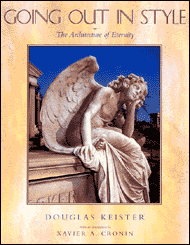|
Description :
|
Winter Mausoleum Door
Allegheny Cemetery
Pittsburgh, Pennsylvania
This is the entry to the Winter mausoleum in Allegheny Cemetery in Pittsburgh. Emil Winter (1857-1935), was president of the Workingmen’s Savings Bank and Trust Company in Pittsburgh and was head of a number of metal production companies. He had a large overseas plant in Austria, for processing manganese ore and was one the founders of the Pittsburgh Steel Company. An exact twin of the mausoleum, built a decade earlier in Woodlawn Cemetery in the Bronx, is the resting place of five and dime store tycoon, F.W. Woolworth.
Carved into the cavetto cornice above the door are a pair of vulture wings, representing maternal care. At the center is a round orb representing the sun and surrounding the sun are twin cobras, symbolizing death. The door is a veritable orgy of symbols. Marching around the door are a series of lotus blossoms symbolizing immortality , punctuated with 12 petaled flowers, a common decoration in both Eastern and Western art. On the left hand upper inset is a vulture symbolizing motherhood and maternal care; on the right is a falcon, the king of the birds an Egyptian symbol for the word of God. Surrounding the two birds is a parade of hieroglyphs including, geese, vipers, snakes, stars, crosses, moon signs, water signs and triangles. On the bottom is a row of pine apples (cones) that, in Egyptian mythology, symbolize fertility.
The figure in the center appears to be a representation of Neferten, the god of fragrance. On top of his head, he wears a lotus blossom, the first flower to open in the morning and a symbol of immortality. In his right hand he carries an ankh one of the most recognizable Egyptian symbols. A number of different meanings have been attached to the ankh, including sexual union, enthusiasm for life, life after death and healing. But all are related to having a long passionate life and afterlife. The ankh is often depicted being carried by the Gods. It combines two Egyptian symbols, the T cross, or tau, (the symbol of Osiris) and the oval, (the symbol of Isis).
The other two figures are, most likely, a blend of various gods and goddesses.
|

